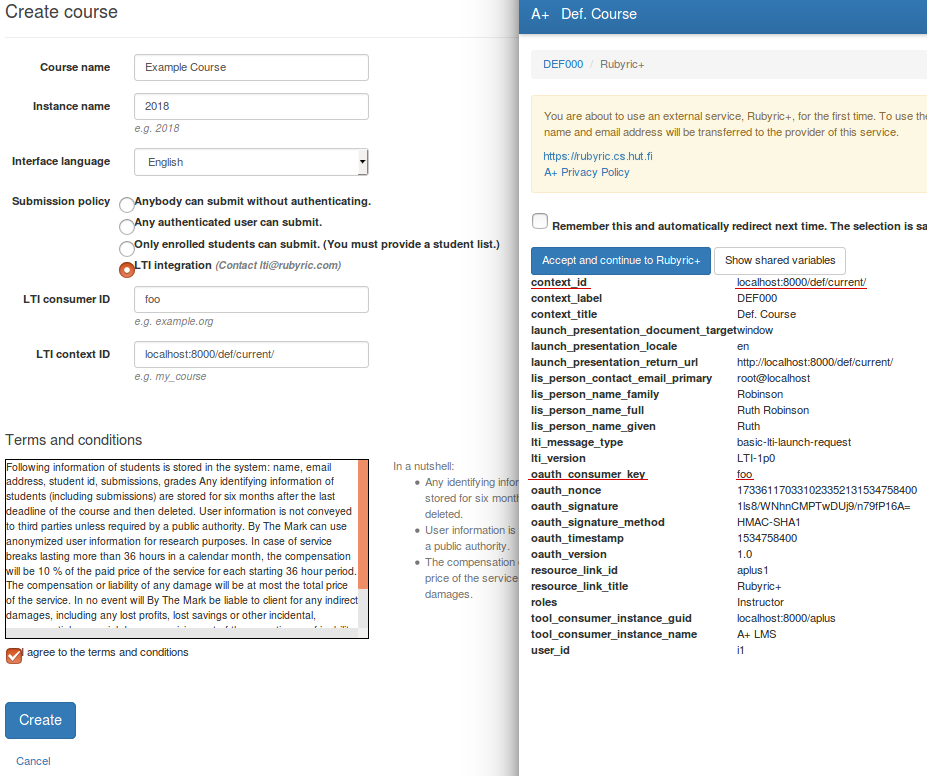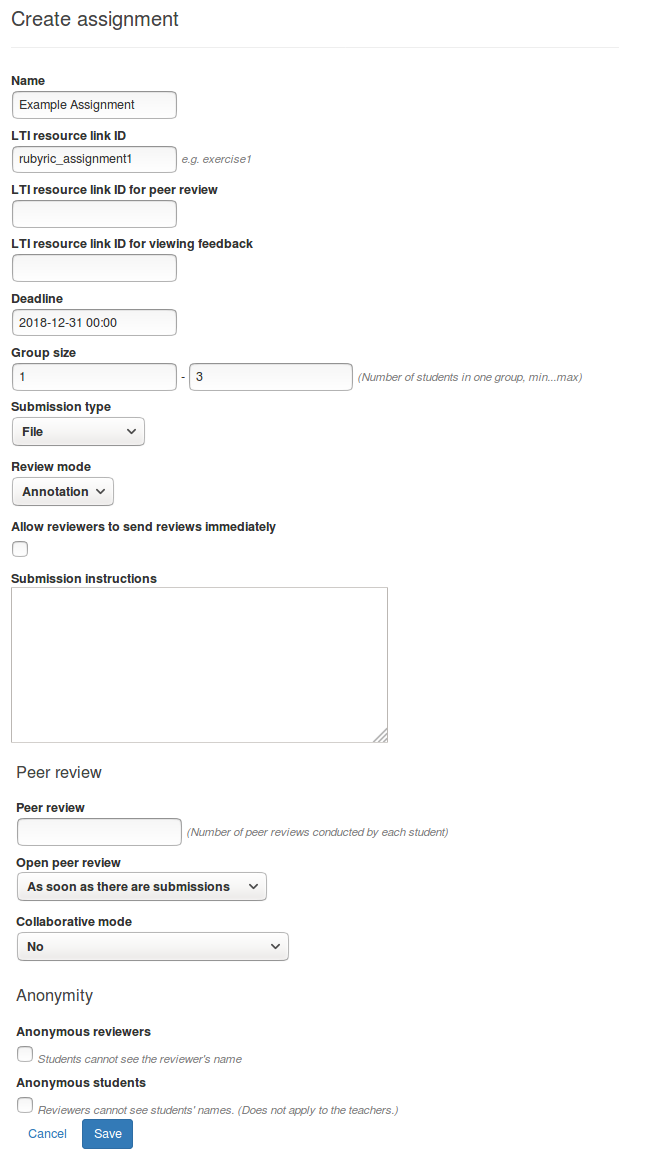TESTING AREA for teachers - real service at plus.tuni.fi
- TIE-99001
- 9. Module 6 - Rubyric
- 9.2 Getting Started with Rubyric
Getting Started with Rubyric¶
- Main questions:
How to create courses and assignments in Rubyric? How they can be linked to A+?
- Topics?
Creating and modifying courses, course instances and assignments.
- Difficulty:
Easy
- Laboriousness:
An hour at most
Add Rubyric to the course menu in A+¶
You can login to Rubyric through A+ after adding Rubyric as a menu item. To add a new menu item in A+ choose Edit course and Menu and press Add new menu item. You can also choose to use Rubyric through Haka login. In that case you don’t need to add Rubyric to menu.
Configure course at Rubyric¶
Create course and course instance¶
Login to Rubyric. If course has yet to be created at Rubyric when logging in with lti, you will be redirected to create course form. When logging in with Haka, choose to create new course. Create course button might not be visible if you have previously only been a student or a reviewer in some course. In that case you can find a “create course” form at https://rubyric.cs.hut.fi/course_instances/new.
Creating a new course in Rubyric automatically also creates a new course instance for the course. There can be several course instances for a course: if the course is taught every year, each year can be its own instance. Each course instance have their separate assignments, reviewers and students. To create a new course instance to existing course, navigate to course by clicking its name on the front page and click on “Create new course instance”. The instructors of the course are persons who have rights to all the instances of the course.

Fill in the form. If you wish to connect Rubyric and A+, choose “LTI integration” as the submission policy. The option “Anybody can submit without authenticating” allows anyone to submit to assignments after they have provided their email address. This can be useful on MOOCs. “Any authenticated user can submit” requires the students to login to Rubyric before they can submit. When choosing “only enrolled students can submit”, the instructor needs to provide list of students who are allowed to submit.
To properly connect Rubyric course to an A+ course, you need to fill in the
LTI consumer ID and the LTI context ID. These can be given, if you have
chosen an LTI integration as the submission policy. You can find the right
context id and consumer id in A+ by choosing Rubyric at the menu, and then
clicking “Show shared variables”. The consumer id is shown in A+ as
oauth_consumer_key and the context id is shown as context_id.
If you are redirected straight to Rubyric instead of having chance to
choose “Show shared variables”, or you do not want to include the LTI login,
you can try using plus.cs as consumer id and the address of your course
plus.cs.hut.fi/something/something/ as the context id. Notice the missing
https:// at the beginning and the slash / at the end.
Warning
If the LTI login directs you to create course form again after you have configured an LTI course, there is probably some mistake in LTI context ID or the LTI consumer ID, and you should fix them by updating course instance (see below).
Updating the course¶
You can change the course settings going to the front page of the course on Rubyric, clicking the link Settings under Course at the menu on the left. The settings of the course instance are in the same menu below the corresponding title Instance.
At the course settings page you can change the name of the course, as well as the contact email, the course code and the time zone. At the course instance settings page you can change the name, the language and the submission policy of the course instance. You can also switch the course instance to inactive so that it won’t accept any more submissions.
Creating an assignment¶
Click the name of the course instance at the course front page. Now Rubyric shows the list of the assignments for this course instance. Click on Create new assignment button to create a new assignment. Fill in the form.
Each assignment must have a unique name. You can define a deadline for the exercise. Students can submit to assignment even after defined deadline, but late submissions will be shown red for reviewers.
The Group size settings defines the size of group (persons) allowed to make submissions. The Submission type affects what kind of submissions Rubyric asks for from students. You can choose submissions to be made as files, written in text area or both together.
Review mode affects on what kind of reviews will be done. More about reviews on Rubrics and reviews. If you cross “Allow reviewers to send reviews immediately”, reviewers are allowed to send reviews back to students right after finishing review. Otherwise instructors will have to send reviews afterwards. Rubyric also allows students to conduct peer reviews. If peer review count is left empty, no peer review is expected. On the other hand collaborative mode allows students to construct feedback for each other but they are not required to review other people’s submissions.
Check out the chapter LTI configuration in A+ to find out how to configure an LTI exercise in A+. At Rubyric, the “LTI resource link ID” of the assignment should be same as Resource link id in A+ exercise. You don’t have to fill in “LTI resource link ID for peer review” and “LTI resource link ID for viewing feedback” unless you want to use Rubyric’s peer review or want students to view the feedback at Rubyric. The service url for assignment is shown on assignment page after you have created assignment.

Submissions¶
Once you have configured exercise in both A+ and Rubyric, submissions should be delivered to Rubyric where they can be assessed.
If you want students to submit straight to Rubyric, you can provide students with submission url which they can use. Submission url is shown at assignment page.